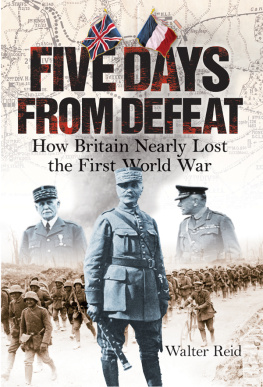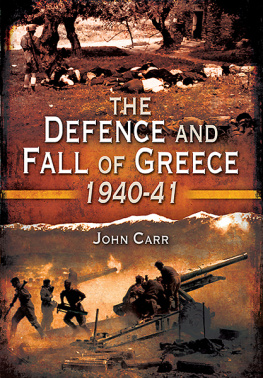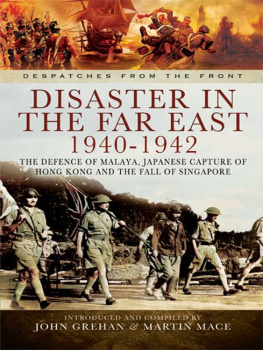Mussolinis Defeat at Hill 731, March 1941
Mussolinis Defeat at Hill 731, March 1941
How the Greeks Halted Italys Albanian Offensive
John Carr
First published in Great Britain in 2020 by
Pen & Sword Military
An imprint of
Pen & Sword Books Ltd
Yorkshire Philadelphia
Copyright John Carr 2020
ISBN 978 1 52676 503 1
eISBN 978 1 52676 504 8
Mobi ISBN 978 1 52676 505 5
The right of John Carr to be identified as Author of this work has been asserted by him in accordance with the Copyright, Designs and Patents Act 1988.
A CIP catalogue record for this book is available from the British Library.
All rights reserved. No part of this book may be reproduced or transmitted in any form or by any means, electronic or mechanical including photocopying, recording or by any information storage and retrieval system, without permission from the Publisher in writing.
Pen & Sword Books Limited incorporates the imprints of Atlas, Archaeology, Aviation, Discovery, Family History, Fiction, History, Maritime, Military, Military Classics, Politics, Select, Transport, True Crime, Air World, Frontline Publishing, Leo Cooper, Remember When, Seaforth Publishing, The Praetorian Press, Wharncliffe Local History, Wharncliffe Transport, Wharncliffe True Crime and White Owl.
For a complete list of Pen & Sword titles please contact
PEN & SWORD BOOKS LIMITED
47 Church Street, Barnsley, South Yorkshire, S70 2AS, England
E-mail:
Website: www.pen-and-sword.co.uk
Or
PEN AND SWORD BOOKS
1950 Lawrence Rd, Havertown, PA 19083, USA
E-mail:
Website: www.penandswordbooks.com
S. ALBANIA AND N.W. GREECE

BEGINNING OF THE BATTLE

GREEK 1ST DIVISION DEFENSIVE POSITIONS 9 MARCH

List of Illustrations
Illustrations to be found in the plate section in the centre of the book.
Mussolini viewing the Greek positions from Komarit.
Major Dimitrios Kaslas.
An Italian attack on Hill 731. The second man from the right appears to have just been hit.
Bersaglieri go into the attack on or near Hill 731.
Mussolini and General Gambara (right).
Members of the Greek Army 1940 Re-enacting Team simulate the defence of Hill 731.
Framework of an ammunition-carrying mule saddle against a background photo of a Greek Army supply train.
The Greek Army 1940 Re-enacting Team demonstrating a machine gun defence.
Unknown artists impression of the final moments of Captain Giorgio di Borbone, 19 March 1941, on a memorial postcard.
Italian-made Gnutti 51cm bayonet (restored).
The view north from Kelyre along the Desnitsa Valley, with the Trebeshin range on the left.
The Proi Math ravine, as seen from what remains of the Kelyre-Berat road.
The summit of Hill 731 as it is today.
Mortar grenades and helmets recovered recently from Hill 731.
Somewhat neglected memorial to the 38th (Puglie) Division near the summit.
Italian shell discovered by the author on the east slope of Hill 731.
Hills 731 and 711 (left and right respectively), as seen from the south.
Hill 717 and Mali Spadarit beyond, seen from Hill 731.
The Greek war cemetery at Kelyre.
Evangelia Fatsea with a photograph of her grandfather, Sgt Maj Halamabos Kyriakakis of the 14 Regiment, 5th (Crete) Division, still unaccounted for, at the Kelyre war cemetery, October 2019.
Prologue
Someday some historian will seek the truth about what happened then, and delve into dusty archives to find it. Then he will give the world a picture of the superb action of the battalions and batteries, but in brief, and thus completely cold. What will be missing is the mental uplift of the warrior as well as the enthusiasm of deciding on the ultimate sacrifice. And, searching through some book or orders of the day he may find some entry such as: March 1941. Soldier X is hereby deleted from the regimental roll as killed, fighting heroically on Hill 731. And after some years a researcher will with difficulty try to read the soldiers name, but in the meantime the ink will have faded. And later still, more historians will be completely unable to read the soldiers name as the writing will have been entirely obliterated.
T hose words were, in a way, about me.
The someday was in early 2019, and I was the some historian who was delving into the dusty archives of the Hellenic War Museum in Athens. As I read this I sat bolt upright at the desk and looked up from the yellowing pages, listening to this faint yet distinct voice from the past. That voice had been muted for many decades, waiting with infinite patience for someone to tap into it. The experience was a healthily humbling one; it fired me up to try to do justice to those brave men on both sides inexplicably neglected by the great bulk of World War Two historiography involved in the epic battle for Hill 731. Would I actually be able to call up even a small part of that mental uplift and enthusiasm for the ultimate sacrifice that is so politically incorrect (not to say incomprehensible) in our digitally-dulled and much less noble age?
Whether or not I have succeeded in this, only the reader can decide. Which historian, writing at a remove of, say, two or three generations from his subject, has indeed any hope of reproducing the unique and indescribable experience of a battlefield in the mind of a reader? But it is our job nevertheless to try. This book will attempt to recapture the sheer intensity and, yes, horror of the month-long battle of Hill 731 between the Greek and Italian armies that has never before been adequately told in English.
The words beginning this prologue were written in 1949 by George Kitsos, a Greek military officer, in the preface to his work, The Italian Spring Offensive. In that year, memories were still fresh of the desperate battles in the Albanian mountains in 1940 and 1941 when Mussolinis troops invaded Greece, hoping to neutralize that country as a potential British ally, but instead found themselves driven back by an unexpectedly hardy foe. Among the dusty tomes of the Hellenic War Museum I sensed someone figuratively looking over my shoulder in silent encouragement and perhaps gratitude that someone in the second decade of the twenty-first century was taking the trouble to find out what happened on Hill 731, one of the most blood-stained heights in modern military history. Kitsos words are also a sobering reminder of the relentless march of time, the enemy of all remembrance an enemy against which the conscientious historian can wield only flimsy weapons.












